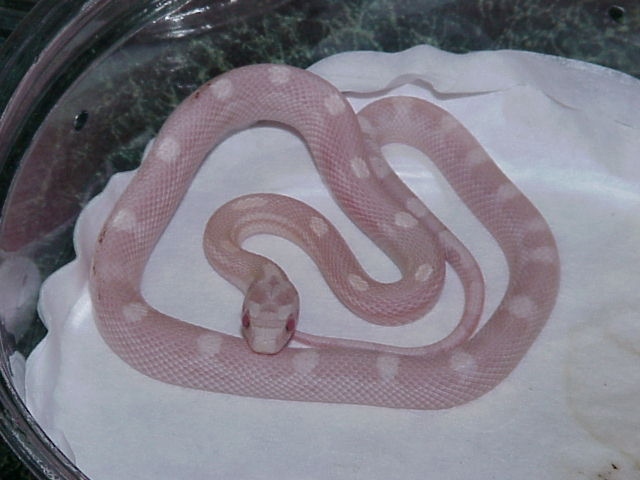I think it would be instructive to figure out what it would take to produce things like Butter Motleys het for Anerythrism. Kind of a reverse progeny predictor. What parents are necessary to be able to produce a given animal...... (this is a job for Super SerpWidgets!)
To produce a Butter Motley het for Anerythrism, you would pretty much need to have one of the adults in the pairing a quad homozygous animal. In this case it would be an animal homozygous for Caramel, Amelanism, Motley, and Anerythrism. As far as I know, there are none like that on the face of the earth at this moment. I did produce an Anerythristic Motley from Caramel Motley parents a couple of years ago, so I know the possibility is lurking around in my gene pool for a Snow Butter Motley.
Every year I see animals being sold that it just is not very likely they can be what the person is claiming they are. So be wary if you see something VERY exotic being sold with even more exotic genes being claimed as heterozygous.
Heterozygous animals are a necessary evil in what we are doing. The more genes that are heterozygous, the more evil it becomes. I've been doing a number of triple het crosses for years, and I despise it. Although the results can sometimes be rewarding, you find that you have to keep a huge colony of gene carriers on tap for breeding in order to overcome the hurtle of the statistical odds of producing what you are looking for. Don't rely on pure luck! Although it can happen, it is much more the exception than the rule.
As far as something like quad hets, forget it. I'd rather get a root canal. I forget what the odds are for a quad homozygous animal, but I think it's 1 in 256. So that means figuring on an average clutch of 16 eggs, I would have to have 16 females allocated to this project (plus at least half that many males) just to be in the running to produce a single solitary animal. IF I'm lucky enough. Since I sure would like to have a pair of them, double the number of adults. When I would finally produce this pair of quad homozygous animals, the COST of doing so would be pretty high.
So, LindsayMarie, to answer your question, I would have to say honestly that working with homozygous animals is the way to go. If you want to breed it to something else, say like an Opal corn, you would get much quicker results of getting something interesting rather than using hets. But even then, the results you would get would be Amelanistics het for Lavender, Caramel, and Motley, so we are back in the 1 in 64 odds again, but even the secondary products will be worthwhile. Personally, for this particular project, I would rather breed a Butter Motley to an Opal Motley to give me much better odds to work with.
The problem with breeding het to het together, is that all of the animals that are not clearly identifiable would ONLY be possible hets. So the 'luck' thing would be a deciding factor as to what sort of results you will get in the next generation.
Does this help?
 Get 2 more pairs next year! *sighs* Well anyways, I think I have decided to go with the Butters this year and next year go with the lavenders and more butters. Anyways, my question is:
Get 2 more pairs next year! *sighs* Well anyways, I think I have decided to go with the Butters this year and next year go with the lavenders and more butters. Anyways, my question is:
